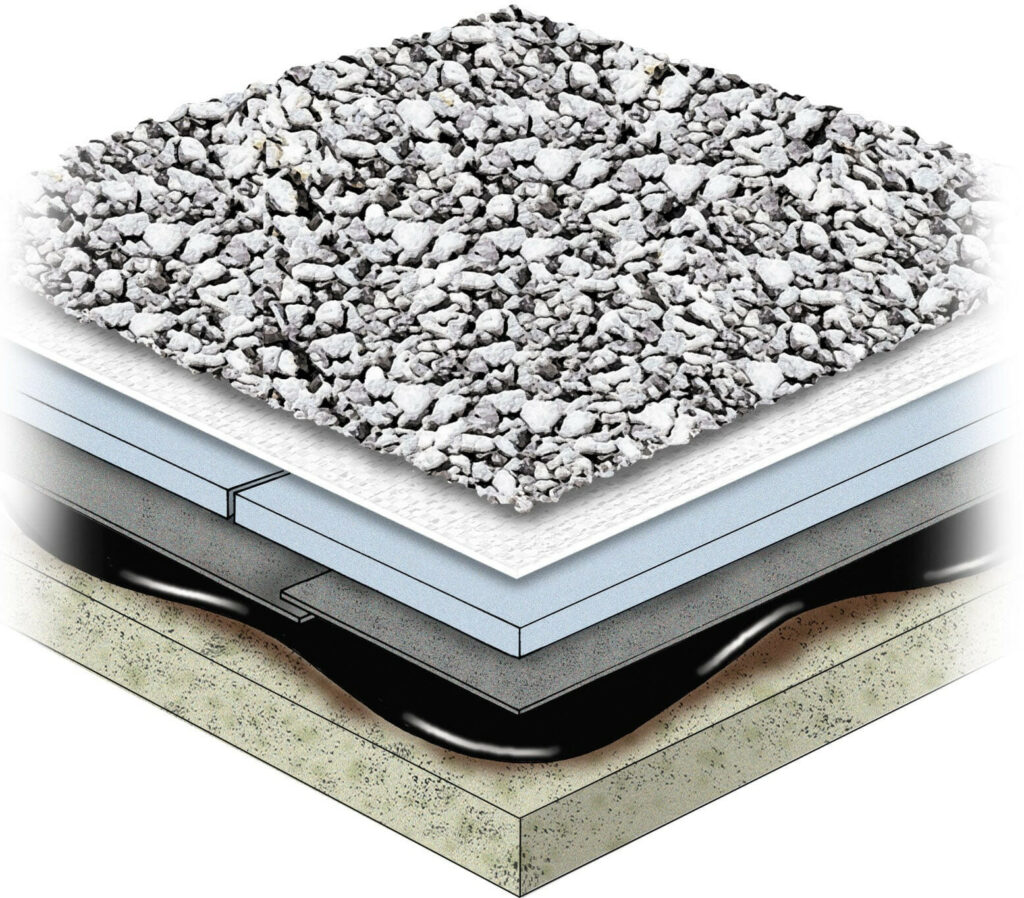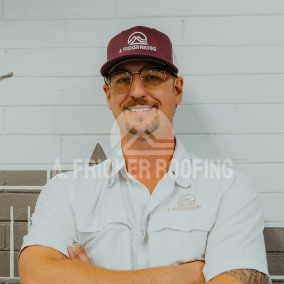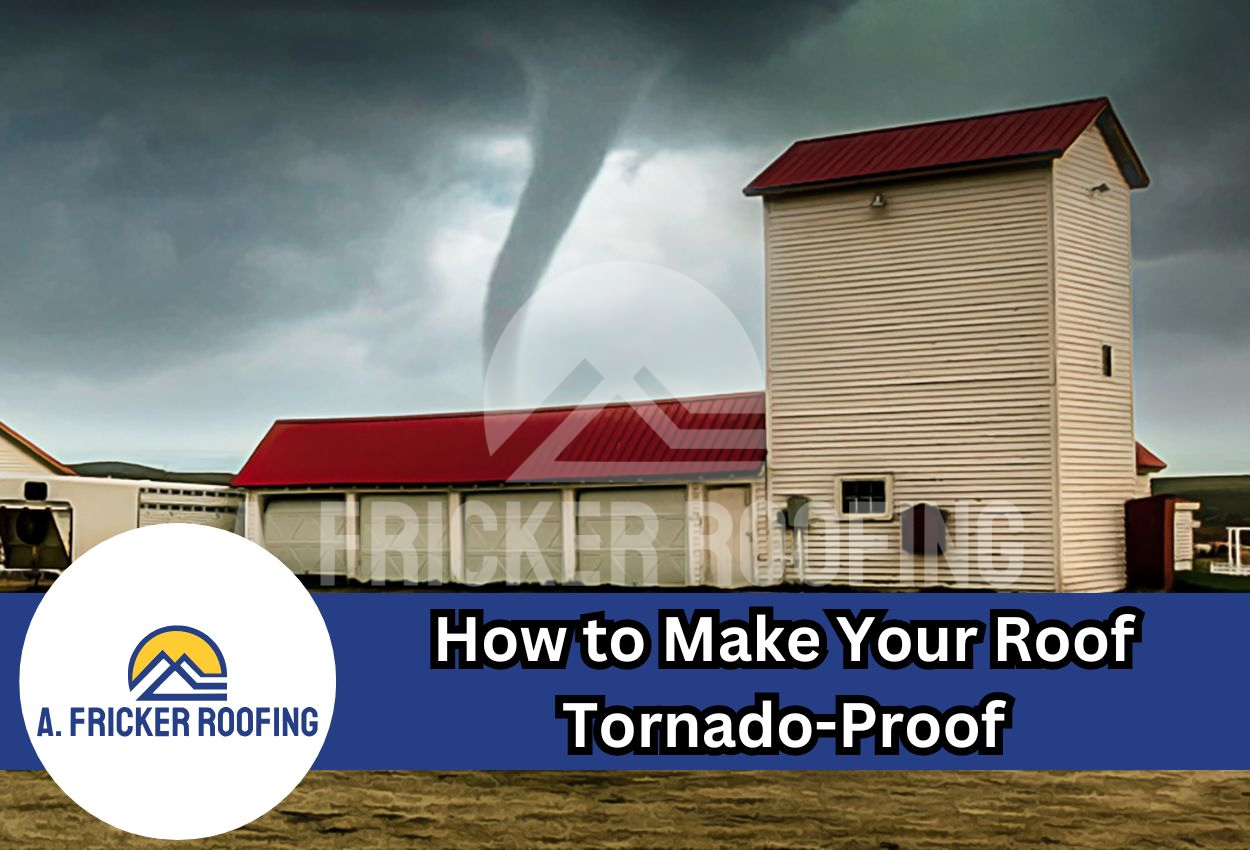
Do you want to install a ballasted roof? Read this blog post to make the right decision for your commercial building.
What Is A Ballasted Roof?
A ballasted roof is a type of roofing system that utilizes the weight of heavy materials to hold the roofing membrane in place. Unlike traditional roofing systems that rely on adhesives, screws, or mechanical fasteners, ballasted roofs are secured using ballast materials, providing a unique and effective way of keeping the roofing material in position.
Traditional roofing systems, such as those with shingles or metal panels, rely on fastening methods to keep the roofing layers intact. Ballasted roofs, on the other hand, do not require penetrations in the roofing membrane, making them less prone to leaks and potential damage.
The Anatomy of A Ballasted Roof

1. Membrane Layer
At the heart of every ballasted roof, you’ll find a membrane layer. This layer serves as the primary waterproofing barrier, keeping rain, snow, and other elements at bay. It can be made of various materials, like EPDM or TPO, making it flexible and highly durable.
2. Insulation Layer
Beneath the membrane lies the insulation. This layer acts as a thermal barrier, keeping your building cozy in the winter and cool in the summer. The insulation plays a major role in temperature regulation.
3. Ballast
In the context of roofing, ballast refers to heavy materials used to hold down the roofing system. These materials not only keep the roof in place but also provide additional benefits such as thermal mass and wind uplift resistance.
Various materials can be used as ballast, including gravel, river rocks, concrete pavers, and even vegetation in the form of a green roof. Each material has its own set of advantages and considerations.
Materials Used On Ballasted Roofs
Ballasted roofs rely on specific materials to get the job done. Let’s explore the primary components used for these roofing systems.
Gravel or Crushed Stone
Gravel is a common choice for ballast due to its affordability and availability. Its weight provides excellent stability for the roofing membrane, keeping it in place during extreme weather conditions.
Pavers and Concrete Slabs
Concrete pavers and slabs are another popular option for ballasted roofs. They come in various shapes and sizes and offer a more visually appealing ballast option.
Lightweight Aggregates
For certain roof structures that can’t handle the weight of traditional ballast materials, lightweight aggregates provide a viable alternative. They offer stability without adding excessive stress to the roof.
How Do Ballasted Roofs Work?
It’s a valid question. What keeps the rocks up there? Won’t they just fall off in strong winds or storms? The key is the balance and stability of the roofing system. Installing a ballasted roof involves several key steps, including preparing the roof deck, laying down the roofing membrane, and evenly distributing the ballast material across the surface.
A ballasted roof relies on the well-coordinated installation of materials. The ballast provides the weight necessary to resist wind forces and prevent the roof from becoming a flying carpet. The ballast is distributed evenly so that it prevents the roof from collapsing under pressure.
Moreover, ballasted roofs are designed with a slight slope to facilitate water drainage. The waterproofing layer beneath the ballast ensures that the roof remains leak-free.
Also Read: 8 Signs Your Commercial Roof Needs An Inspection ASAP
Advantages Of Ballasted Roofs
1. Superior Weather Protection
One of the primary advantages of ballasted roofs is their exceptional ability to withstand harsh weather conditions. No matter what Mother Nature throws at your roof, the ballast acts as a powerful anchor, ensuring your roofing system stays intact and your property remains protected.
The sun’s relentless UV rays can wreak havoc on traditional roofs, causing premature deterioration and cracking. However, ballasted roofs provide an added layer of defense by absorbing and dispersing these harmful rays, preserving the integrity of the underlying membrane.
2. Enhanced Energy Efficiency
Ballasted roofs are known for their cool roofing properties. The reflective surface of the stones or pavers minimizes heat absorption, keeping your building cooler and reducing the need for excessive air conditioning.
Not only do ballast roofs help keep your building cool in hot weather, but they also provide excellent insulation during colder months. The thermal mass of the ballast aids in maintaining a comfortable indoor temperature, leading to energy savings on heating costs.
3. Cost-Effective
When it comes to roofing projects, the cost is a significant factor to consider. Ballasted roofs offer a cost-effective solution compared to some other roofing systems. The installation process is relatively simple, requiring fewer materials and labor hours, which translates to cost savings for you.
Maintaining a roof can be an ongoing expense, but with ballasted roofs, you’ll be pleasantly surprised at how minimal the maintenance requirements are. The ballast material acts as a protective barrier against debris and potential damage, reducing the need for frequent repairs and lowering maintenance costs in the long run.
4. Durability and Longevity
A roof’s durability is crucial in ensuring the longevity of your investment. Ballasted roofs are known for their exceptional resistance to wear and tear. The ballast material helps protect the roofing membrane from the elements and physical damage, making the roof more resilient over time.
Due to their robust construction and protective properties, ballasted roofs can have an extended lifespan compared to many traditional roofing options. With proper care and maintenance, these roofs can last for decades, saving you from premature replacements.
5. Easy Repairs and Maintenance
In the event that repairs are necessary, ballasted roofs offer a practical advantage. The ballast can be easily removed and replaced, simplifying the repair process and reducing the time and effort required to get your roof back in top shape.
In addition, you can forget the hassles of regular roof maintenance and enjoy peace of mind with ballasted roofs. With minimal maintenance demands, you can spend less time worrying about your roof and more time on the things that truly matter.
Disadvantages of Ballasted Roofs
1. Increased Roof Weight
Imagine placing heavy rocks on top of your roof. One of the significant disadvantages of ballasted roofs is the increased weight on the roof that is formed. Roofs are designed to bear a certain amount of weight and by adding a ballast, you may be pushing your roof’s limits. This can lead to structural problems and your roof’s overall integrity.
2. Membrane Damage and Wear
Your roofing membrane acts as a protective layer, shielding your roof from the elements. However, the membrane might experience abrasion and wear due to the heavy materials on top. Over time, this can compromise the membrane’s effectiveness, making your roof vulnerable to leaks and other issues.
3. Leak Possibilities
With all that weight pressing down, your roof might develop weak points, allowing water to sneak through. Nobody wants to deal with water dripping from their ceiling. So, if you’re considering a ballasted roof, you must address leak concerns and take preventive measures.
4. Risk of Roof Penetrations
Roof penetrations refer to any openings or protrusions on your roof, like vents or chimneys. Ballasted roofs can increase the risk of leaks around these penetrations. The ballast might interfere with proper waterproofing and insulation, leaving your roof vulnerable to water damage.
5. Weathering and Erosion Issues
Roofs face the brunt of weather conditions. From scorching heat to heavy rain, they endure it all. Ballasted roofs, too, have their share of weather-related challenges. The ballast materials can weather and erode over time, leading to roof performance issues. It’s like your roof is fighting a constant battle against nature’s forces.
Can You Install Solar Panels On Your Ballasted Roof?
The answer is both yes and no. While it is possible to install solar panels on ballasted roofs, it requires careful planning and consideration of various factors.
Before moving forward with a solar panel installation on a ballasted roof, it’s essential to conduct a thorough assessment of the roof’s structural capacity. A professional solar panel installer can evaluate whether the roof can support the additional weight of the solar panels and mounting system without compromising its integrity.
Consider these 10 Things Before Hiring a Commercial Roofing Company.
Is a Ballasted Roof Right for You?
After weighing the advantages and drawbacks of ballasted roofs, the question remains: is it the right choice for your building or home? The answer depends on various factors, including your budget, location, building structure, and environmental priorities.
If you’re looking for a cost-effective roofing option that provides decent energy efficiency and requires low maintenance, a ballasted roof could be an excellent choice. However, if your location is prone to strong winds or if your building’s structure is not designed to handle the additional weight, you might want to consider alternative roofing systems.
Consulting with a professional roofing contractor is essential in making an informed decision. They can assess your specific needs and recommend the best roofing solution for your situation.
Do You Want To Install A Ballasted Roof In Tulsa, OK?

Are you considering installing a ballasted roof on your commercial building? It is best to consult roofing professionals before starting the project. They can weigh the pros and cons of installing a ballasted roof on your property and then proceed with any decision you make. Contact A. Fricker Roofing and Waterproofing today at (918) 402-7167 and consult our roofing experts about ballast roof installation.



